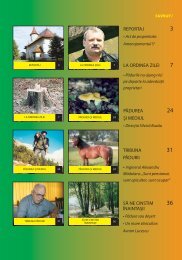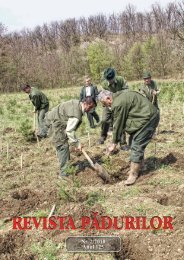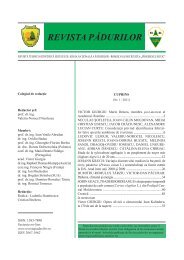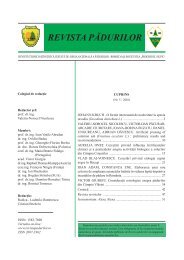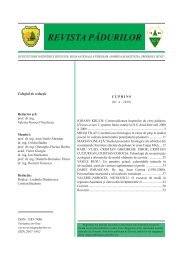şi prof.dr. W. Zwölfer - Revista Pădurilor
şi prof.dr. W. Zwölfer - Revista Pădurilor
şi prof.dr. W. Zwölfer - Revista Pădurilor
You also want an ePaper? Increase the reach of your titles
YUMPU automatically turns print PDFs into web optimized ePapers that Google loves.
ments, some of which have been thinned recently according<br />
to Romanian norms and others which are old<br />
enough to undergo the first thinning. In one of this<br />
latter stands, a practical demonstration of a thinning<br />
from above was performed.<br />
After this activity, by using a specially designated<br />
form all participants were asked to carry out (within<br />
the demonstration plot established earlier) a thinning<br />
from above as explained previously. This activity<br />
had included two separate operations to perform:<br />
a. Selection of final crop trees (“les plus beaux<br />
des plus gros”) based on three main criteria: vigor,<br />
quality and spacing;<br />
b. Selection of trees to be removed (thinned)<br />
during the first intervention to follow in order to improve<br />
the growth of those individuals chosen as final<br />
crop trees.<br />
Subsequently, the results have been gathered and<br />
the data analysis was performed.<br />
3.2. Main results of field exercise<br />
The 15 participants had spent an hour to check all<br />
trees within the plot and select both final crop trees<br />
and trees to thin. The results of this work are shown<br />
in the table no. 6, 7, and 8.<br />
Table 6<br />
some some relevant relevant data on data final on crop final treescrop<br />
trees<br />
Participant<br />
no...<br />
No./<br />
plot<br />
Final crop trees<br />
No./<br />
ha<br />
% of initial<br />
trees/plot<br />
1 21 105 8<br />
2 30 150 11<br />
3 21 105 8<br />
4 18 90 7<br />
5 20 100 7<br />
6 12 60 4<br />
7 66 330 24<br />
8 25 125 9<br />
9 35 175 13<br />
10 18 90 7<br />
11 23 115 9<br />
12 17 85 6<br />
13 23 115 9<br />
14 22 110 8<br />
15 36 180 13<br />
On average, 25 final crop trees/plot (range 12-66)<br />
meaning 125 trees/ha (range 60-330 trees/ha) were<br />
chosen by participants. It represents only 9% (range<br />
4-24%) of initial trees of the stand. It seems that this<br />
mean density of final crop trees (N/ha) is quite low<br />
but it is enough taking into account the vigour and<br />
especially the quality of these trees. In addition, this<br />
density is much higher than the one recommended in<br />
other central European countries with a longer tradition<br />
in European beech silviculture as follows: maximum<br />
70 trees/ha in France (Bock et al., 2005), 60-80<br />
trees/ha in Germany (von Teuffel and Hein, 2004),<br />
80 trees/ha in Belgium (Baar et al., 2004). Most of<br />
these individuals are European beech trees but some<br />
participants have also selected a few hornbeams or<br />
other broadleaved species. Such solution should have<br />
been avoided as both hornbeam and other broadleaves<br />
have a shorter life span and rotation age so can<br />
not contribute to the stand when reaching the rotation<br />
age of European beech.<br />
Taking into account all participants, the final<br />
crop trees had a mean diameter of 19.4 cm and a<br />
mean height of 19.4 m. At individual level, the mean<br />
diameter of final crop trees varies from 16.9 cm and<br />
23.2 cm (range = 6.3 cm) whereas the range of mean<br />
heights is much lower (1.0 m, from 19.0 m up to 20.0<br />
m) (table 7).<br />
As for the trees marked for thinning, their number<br />
within the plot varies from 28 to 170 (140-850<br />
trees/ha) or between 10% and 63% of trees found in<br />
the demonstration plot. Concerning the species to be<br />
thinned, on average more than 77% (range 66-94%)<br />
of number of trees belong to European beech, 16%<br />
(range 6-25%) to hornbeam and 7% (range 0-17%) to<br />
other broadleaves.<br />
A similar high variety of situations is found when<br />
taking into account the volume to thin per hectare which<br />
ranges between 46.8 cu.m and 174.3 cu.m. However,<br />
in case of only 6 participants out of 15 this volume is<br />
lower than 100 cu.m/ha.<br />
As for the intensity of thinning it ranges between<br />
17 and 58% (by basal area) and between 16 and 59%<br />
(by volume). Obviously these figures are much higher<br />
than the one recommended by the Romanian technical<br />
norms in use (xxx, 2000).<br />
A summary of all data related to the trees marked<br />
for thinning is shown in table 8.<br />
22 REVISTA PĂDURILOR • Anul 126 • 2011 • Nr. 2




